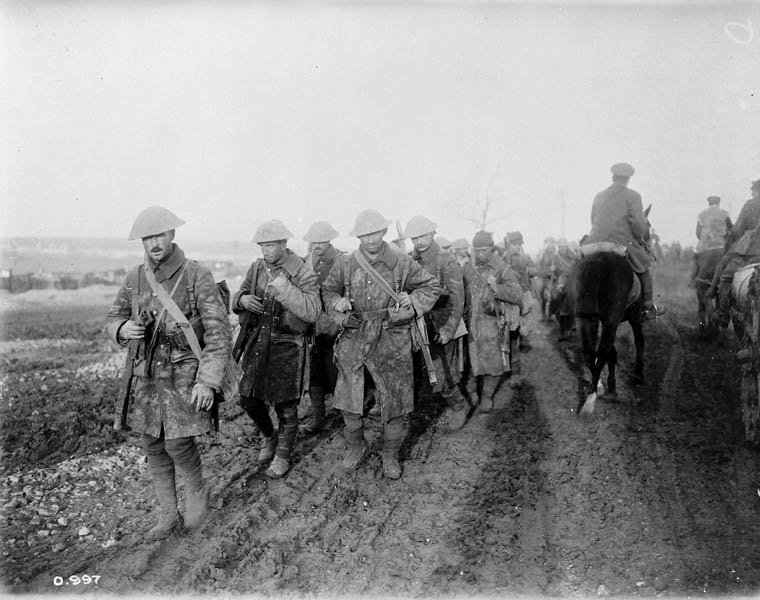During World War I, from 1914-1918, approximately 2,700 Canadian Jews (and possibly more) served in the Canadian Expeditionary Force, with about 1,200 seeing combat. Of those, an estimated 123 died in battle.
This included Samuel Waskey, a printer from Winnipeg who joined the 44th Battalion as a private. Possibly to avoid what demographer Louis Rosenberg referred to as an “unpleasant experience” because he was Jewish, Samuel, 21, had changed his surname to Waskey from Warshawsky. (Other Jewish soldiers took a more drastic step and registered as Protestants.)
Samuel’s parents, Hyman and Sophia Warshawsky, were Polish immigrants who had first lived in London, England, where Samuel was born in 1893. In 1902, the Warshawskys met Jacob Bender, a Jewish land agent, who had come to London to recruit Jewish immigrants for his agricultural colony known as Bender’s Hamlet, about 80 kilometres north of Winnipeg. Hyman, a tailor, and Sophia decided to try their luck as farmers and brought their family to Manitoba (with the financial assistance of the Jewish Colonization Association).
The land Bender had sold the colonists, however, was poor and life at the hamlet was difficult. By 1906, Hyman and Sophia and their seven children had abandoned the colony and were living in Winnipeg’s North End.
The 44th Battalion was part of the 4th Canadian Division. Waskey and his fellow soldiers had reached Britain in late October 1915 and were in France by mid-August 1916. The 4th Division joined the battle at the Somme on Oct. 21. Four days later, it was the turn of the 44th. Without proper artillery support, Waskey and the rest of the regiment had no chance. Most of the men died without reaching the German trench they were attempting to capture. Waskey was only 23 years old. His death is listed on the war memorial at the Shaarey Zedek Cemetery along with eight other Winnipeg Jewish soldiers who died in World War 1.
A year after the tragedy at the Somme, Gen. Douglas Haig, commander of the British Expeditionary Force, insisted that the key to victory on the Western Front was capturing the area around the village of Passchendaele, near Ypres in Belgium. Bad weather had turned the battlefield into a muddy bog. Nonetheless, Haig was determined to proceed.
Among those who paid the terrible price for this ill-conceived decision was Edward Joseph Seidelman, 20, of Vancouver. His father, William, was a Hungarian Jewish immigrant who after living in Kansas and Seattle, had settled in Vancouver in the 1890s. There, he met Esther Pearlman from Winnipeg. The two were married in 1896. Joseph was born a year later, followed by four more children during the next decade.
In 1916, Seidelman was a student at the University of British Columbia. Compelled to do his patriotic duty, he enlisted in the Western Universities 196th Battalion made up of more than 150 students from universities in Manitoba, Saskatchewan, Alberta and B.C. Seidelman was in England by November 1916. Early in 1917, he was sent to northern France and found himself in the mucky trenches of the Western Front.
Seidelman, who wrote his sister Rachel often during the next nine months, hoped that the war might end soon, though he was not optimistic. The “chances of peace do not… look as rosy as I thought,” he noted in a letter on April 7, “but the Huns [Germans] will be defeated ultimately.” (Seidelman’s correspondence can be found on the Jewish Museum and Archives of B.C.’s website.)
In the months that followed, Seidelman fought and survived the Battle for Vimy Ridge, was wounded in the leg in another battle and spent several weeks in an army hospital before being sent back to the front. Then on Oct. 26, the first day Canadian soldiers fought in the carnage at Passchendaele, he was killed. Seidelman was the first Canadian Jewish soldier from Vancouver to die fighting in the war.
Historian and writer Allan Levine’s most recent book is Toronto: Biography of a City.
